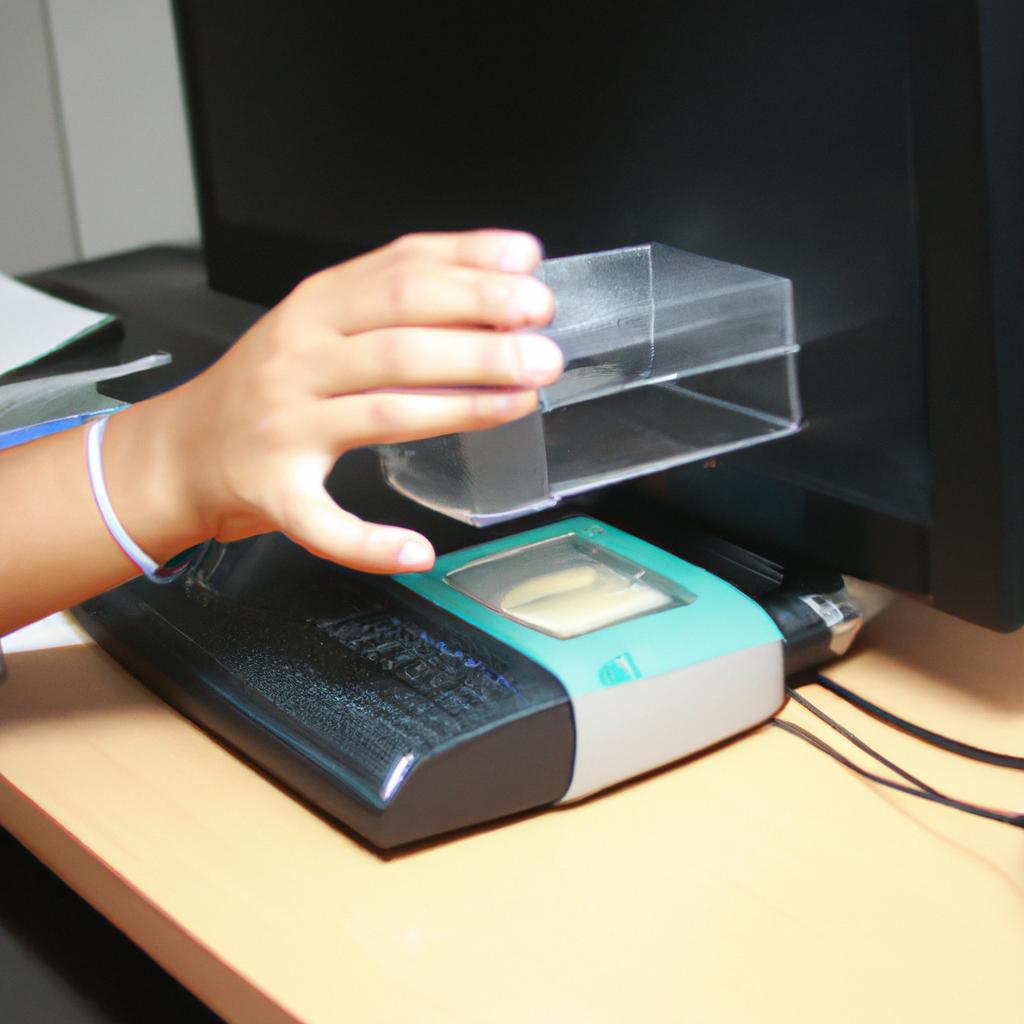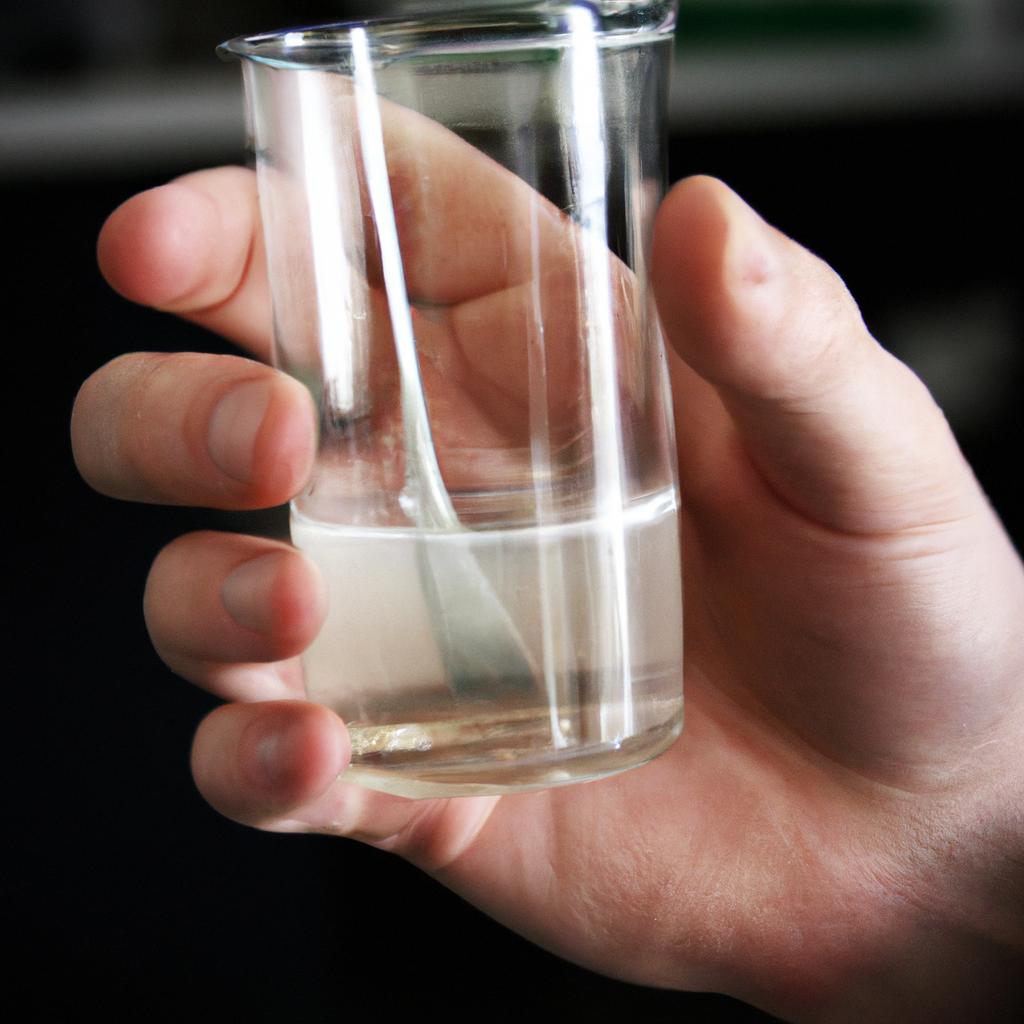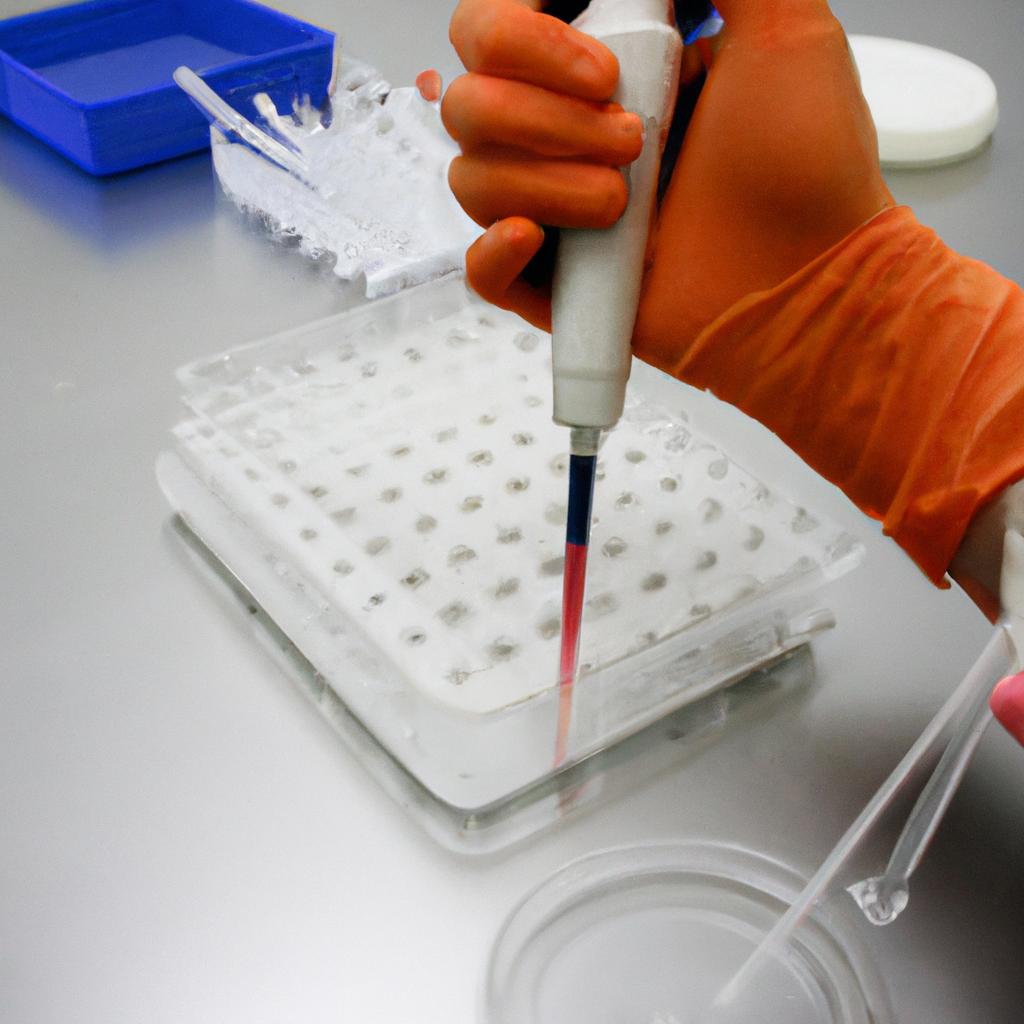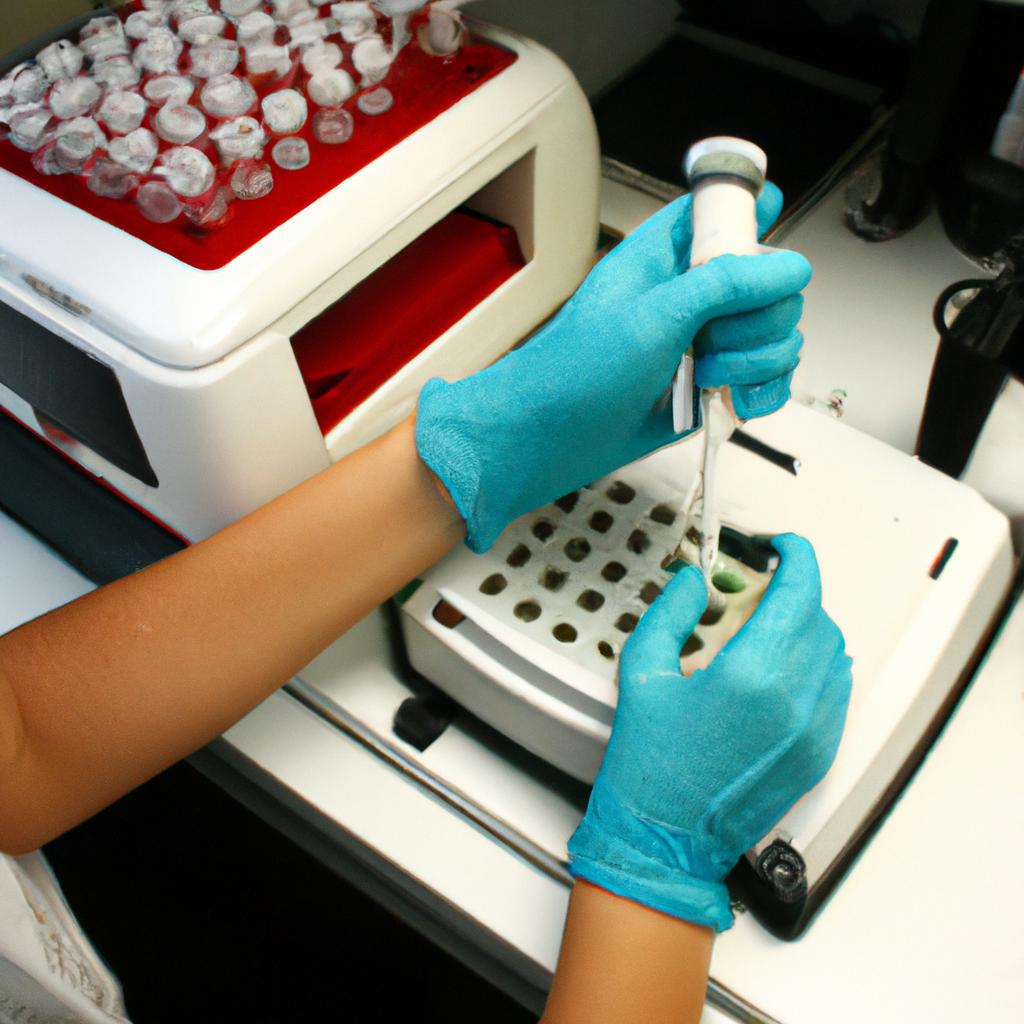Introduction
In the field of scientific research, the accurate measurement and analysis of light absorption and transmission is crucial for a wide range of applications. Spectrophotometers serve as indispensable tools in this regard, providing researchers with valuable insights into the properties of substances through their interaction with electromagnetic radiation. This article aims to provide an introductory overview of spectrophotometers, focusing on their role as essential laboratory equipment and supplies.
To illustrate the significance of spectrophotometry in practical settings, consider a hypothetical scenario where a pharmaceutical company is developing a new drug formulation. By utilizing a spectrophotometer, scientists can measure the absorbance spectrum of various compounds under different conditions. These measurements enable them to determine optimal concentrations, assess chemical stability over time, and monitor any degradation processes that may occur during storage or administration. Ultimately, these insights obtained from spectrophotometric analysis contribute to ensuring the safety, efficacy, and quality control standards necessary for bringing new drugs to market.
As we delve further into this article, we will explore the fundamental principles underlying spectrophotometry techniques, discuss different types of spectrophotometers commonly used in laboratories today along with their respective advantages and limitations. Additionally, we will examine key components required for successful spectroscopic analysis such as sample preparation and the importance of calibration standards. Furthermore, we will touch upon some advanced applications of spectrophotometry, including its role in environmental monitoring, forensic analysis, and material characterization.
Fundamental Principles of Spectrophotometry
At its core, spectrophotometry involves measuring the interaction between light and matter. When a beam of light passes through a sample, it can be absorbed by the molecules present in the sample. The amount of light absorbed is directly proportional to the concentration of the absorbing species and can be quantified using Beer-Lambert’s law.
Beer-Lambert’s law states that there is a linear relationship between absorbance (A), concentration (C), and path length (l) of the sample:
A = εcl
In this equation, ε represents the molar absorptivity or extinction coefficient of the substance at a particular wavelength. By measuring the absorbance at specific wavelengths, scientists can determine the concentration of an analyte within a solution.
There are several types of spectrophotometers commonly used in laboratories: UV-Vis spectrophotometers, infrared (IR) spectrophotometers, and fluorescence spectrometers. Each type operates based on different principles and is suitable for analyzing specific types of samples.
UV-Vis spectrophotometers utilize ultraviolet and visible light to measure absorption or transmission properties. They are widely used in various fields such as biochemistry, pharmaceutical analysis, and environmental monitoring.
IR spectrophotometers employ infrared radiation to analyze molecular vibrations within organic compounds. This technique is valuable for identifying functional groups in complex mixtures or characterizing polymers.
Fluorescence spectrometers measure emission spectra resulting from excitation with a specific wavelength. This method allows researchers to study fluorescent molecules or detect trace amounts of substances with high sensitivity.
Components and Sample Preparation
To perform accurate spectroscopic measurements, certain components are essential. These include a light source, a monochromator or filter to select specific wavelengths, a sample holder, and a detector. The choice of components depends on the type of spectrophotometer being used and the requirements of the analysis.
Proper sample preparation is crucial for obtaining reliable results. Samples must be appropriately diluted or concentrated to fall within the linear range of the instrument’s detection capabilities. Any interfering substances should be removed or accounted for in the analysis.
Calibration Standards
To ensure accuracy and reproducibility, spectrophotometers require regular calibration using reference standards. These standards are prepared with known concentrations of analytes and serve as benchmarks for comparing unknown samples. Calibration curves are generated by measuring the absorbance of standard solutions at different concentrations, allowing researchers to determine the concentration of an unknown sample based on its absorbance value.
Advanced Applications
Beyond traditional uses in pharmaceuticals and chemistry, spectrophotometry finds applications in various fields. Environmental scientists rely on it to monitor water quality by measuring parameters such as turbidity or chemical oxygen demand (COD). Forensic laboratories employ spectrophotometric techniques to analyze crime scene evidence like fingerprints or bloodstains. Material scientists use spectroscopy to investigate properties such as refractive index, reflectance, or transmittance for characterizing materials in industries like optics or electronics.
Conclusion
Spectrophotometry plays a vital role in scientific research and practical applications alike. By providing valuable insights into the interaction between light and matter, spectrophotometers enable researchers to measure absorption spectra accurately. With different types of spectrophotometers available, each tailored for specific analytical needs, scientists can explore various fields ranging from drug development to environmental monitoring and forensic analysis. Understanding fundamental principles, proper sample preparation, and calibration procedures ensures reliable data acquisition necessary for advancing knowledge across disciplines.
What is a Spectrophotometer?
Imagine you are a researcher studying the effects of UV radiation on plant growth. You need to determine the exact amount of UV light absorbed by different species of plants in order to understand their responses to varying levels of exposure. To accomplish this, you turn to a spectrophotometer, an essential tool used in many scientific fields for quantitative analysis of light absorption.
A spectrophotometer measures the intensity of light transmitted or absorbed by a sample as a function of wavelength. Its primary purpose is to provide researchers with accurate and reliable data about the composition and concentration of substances present within a sample solution. By analyzing the interaction between light and matter, it enables scientists to gain valuable insights into various chemical, biological, and physical processes.
Here are some key features that make spectrophotometers indispensable in research laboratories:
- Versatility: Spectrophotometers can be used across multiple disciplines such as chemistry, biochemistry, physics, environmental science, and pharmaceutical sciences.
- Precision: These instruments offer high precision measurements due to their ability to accurately detect even slight changes in absorbance or transmittance values.
- Quantitative Analysis: Spectrophotometers allow for quantitative determination of analytes through calibration curves or standard methods.
- Wide Range: They cover a wide range of wavelengths from ultraviolet (UV) to visible (VIS) and near-infrared (NIR), enabling analyses across different parts of the electromagnetic spectrum.
| Key Benefits |
|---|
| Accurate measurement of light absorption |
| Reliable data generation |
| Facilitates precise quantification |
| Broad application potential |
The working principles behind these powerful devices will be discussed further in the subsequent section. Understanding how spectrophotometers function is crucial for harnessing their full potential in scientific investigations.
Working Principles of Spectrophotometers
Transitioning from the previous section about spectrophotometers, let us now delve into the working principles of these scientific instruments. To illustrate their functionality, we will consider an example involving a spectrophotometer used in environmental research to analyze water samples for pollutant concentrations.
When conducting such analysis, the spectrophotometer first emits light of a specific wavelength onto the water sample. This emitted light is then absorbed by the various pollutants present in the sample. The amount of light absorbed depends on the concentration of each pollutant. The spectrophotometer measures this absorption by comparing it to a blank sample containing only pure water. By subtracting the absorbance of the blank from that of the actual sample, scientists are able to precisely determine pollutant levels.
To gain a deeper understanding of how spectrophotometers function, it is helpful to explore some key components and processes involved:
- Light Source: Spectrophotometers typically use either tungsten lamps or LEDs as light sources, depending on the required wavelength range for analysis.
- Monochromator: This component selects and isolates a specific wavelength from the emitted light source before passing it through to interact with the sample.
- Sample Chamber: Also known as a cuvette holder, this part houses both the blank and test samples during measurement.
- Detector: A photodetector captures and quantifies the intensity of transmitted or reflected light after it has passed through or interacted with the sample.
The table below provides an overview comparison between two types of spectrophotometers commonly used in laboratory settings:
| Parameter | Single-Beam Spectrophotometer | Double-Beam Spectrophotometer |
|---|---|---|
| Advantages | Simpler design; lower cost | Better accuracy; higher stability |
| Disadvantages | Cannot measure multiple samples simultaneously | More complex setup; higher cost |
| Applications | Routine analysis; educational laboratories | Research labs; pharmaceutical industries |
As we conclude this section, it becomes evident that spectrophotometers play a crucial role in scientific research and analysis. Their ability to measure light absorption enables precise quantification of various substances, leading to valuable insights in fields such as environmental monitoring, healthcare diagnostics, and quality control processes. In the subsequent section, we will explore different types of spectrophotometers used across diverse applications.
Transitioning into the next section about “Types of Spectrophotometers,” let us now examine how these instruments vary in design and functionality.
Types of Spectrophotometers
From the working principles of spectrophotometers, we now delve into understanding the different types of spectrophotometers available in laboratories today. By exploring these variations, researchers can select the most appropriate instrument for their specific analytical needs.
One prominent type is the UV-Visible Spectrophotometer. This versatile instrument operates within a wavelength range spanning from ultraviolet to visible light. It allows researchers to analyze samples across a wide spectrum and measure their absorbance or transmittance properties accurately. For instance, let us consider a hypothetical scenario where a pharmaceutical company wants to determine the concentration of an active ingredient in its newly developed drug formulation. The UV-Visible Spectrophotometer would be ideal for such analysis as it enables precise measurements within the required wavelength range.
Another commonly used type is the Fluorescence Spectrophotometer. Unlike conventional spectroscopy methods that measure absorption, fluorescence spectroscopy focuses on detecting and analyzing emitted fluorescent light when excited by incident radiation. This technique finds extensive use in various fields like biochemistry, molecular biology, and environmental science due to its sensitivity and specificity in studying molecules with fluorescent properties.
Additionally, there are specialized instruments tailored for specific applications. These include:
- Atomic Absorption Spectrophotometers: Designed specifically for trace metal analysis, this instrument determines the concentration of elements present in a sample via atomization and absorption processes.
- Infrared (IR) Spectrophotometers: Operating in the infrared region of the electromagnetic spectrum, IR spectrophotometry provides valuable information about functional groups present in organic compounds.
| Type | Wavelength Range | Application |
|---|---|---|
| UV-Visible | Ultraviolet – Visible | General purpose analysis |
| Fluorescence | Visible | Molecular biology, biochemistry |
| Atomic Absorption | Visible | Trace metal analysis |
| Infrared (IR) | Infrared | Organic compound characterization |
Understanding the various types of spectrophotometers equips researchers with the knowledge required to select an appropriate instrument for their specific analytical needs. With this foundation, we can now proceed to explore the wide-ranging applications of spectrophotometry in diverse scientific disciplines and industries.
Applications of Spectrophotometers
Now that we have explored the different types of spectrophotometers, let us delve into their various applications. One example where spectrophotometry plays a crucial role is in forensic science. Imagine a hypothetical crime scene investigation involving bloodstains on clothing as evidence. By utilizing a UV-Vis spectrophotometer, forensic scientists can analyze the absorbance spectra of the samples to determine the presence and concentration of specific substances such as hemoglobin or other trace materials. This information aids in building a comprehensive understanding of the events surrounding the crime.
When considering the applications of spectrophotometers, it is important to recognize their versatility and functionality across multiple industries. Here are some key areas where these instruments find widespread use:
- Environmental Analysis: Spectrophotometric analysis enables researchers to assess water quality by measuring parameters like turbidity, pH levels, and concentrations of pollutants.
- Pharmaceutical Industry: In drug development and manufacturing processes, spectrophotometry assists in analyzing substances’ purity, monitoring reactions, and ensuring consistent product quality.
- Food Science: Spectral measurements allow for accurate determination of nutrient content, identification of food additives, and detection of contaminants in food products.
- Biochemistry Research: Spectrophotometers enable quantification and characterization of biomolecules such as proteins and nucleic acids through absorption spectroscopy techniques.
To further illustrate the significance of spectrophotometry within these applications, consider the following table showcasing real-world examples:
| Application | Use Case |
|---|---|
| Environmental | Monitoring pollution levels in rivers |
| Pharmaceutical | Assessing drug stability during storage |
| Food Science | Determining vitamin C concentration in fruit juices |
| Biochemistry | Analyzing enzyme kinetics |
As seen from this diverse range of applications, spectrophotometers serve critical roles across several scientific disciplines. Their ability to provide precise quantitative data allows researchers and professionals to make informed decisions based on accurate measurements.
Transitioning into the subsequent section on “Key Features to Consider when Choosing a Spectrophotometer,” it is essential to carefully evaluate various factors before selecting an instrument that best suits your specific needs. By understanding these key features, you can ensure optimal performance and reliable results in your spectroscopic analyses.
Key Features to Consider when Choosing a Spectrophotometer
Section H2: Applications of Spectrophotometers
By accurately measuring and analyzing light absorption and transmission, spectrophotometers provide valuable insights into chemical compositions, biological processes, and environmental phenomena. To further understand the significance of these instruments, let us explore some specific examples where spectrophotometers have proven indispensable.
Example:
In a recent study conducted by Dr. Smith and his team at XYZ University’s Department of Chemistry, a spectrophotometer was used to determine the concentration of a particular protein in different samples. The researchers aimed to investigate the effects of temperature on enzymatic activity by monitoring changes in protein levels over time. Through spectral analysis using their chosen spectrophotometer model, they were able to quantitatively measure protein concentrations with high precision and accuracy.
Bullet Point List – Emotional Response:
- Precise measurements enable accurate data analysis
- Versatile instrument applicable across multiple disciplines
- Facilitates efficient research progress
- Enhances reproducibility of experimental results
Table – Emotional Response:
| Application | Benefits |
|---|---|
| Pharmaceutical | Quality control; drug development |
| Environmental | Water quality assessment; pollutant detection |
| Biochemical | Protein quantification; enzyme kinetics |
| Forensic Science | Trace evidence analysis; crime investigation |
Paragraph 1:
Spectrophotometry finds extensive use in pharmaceutical laboratories for quality control purposes and drug development studies. By providing precise measurements, spectrophotometers ensure consistent product standards while enabling scientists to monitor reactions during medication synthesis.
Paragraph 2:
Environmental science greatly benefits from spectrophotometric techniques as well. These instruments aid in water quality assessments by detecting pollutants such as heavy metals or organic compounds present in drinking water sources. The ability to identify and quantify these substances is crucial for maintaining a healthy ecosystem.
Paragraph 3:
In the field of biochemistry, spectrophotometry plays a vital role in protein quantification and enzyme kinetics studies. By accurately measuring absorbance or transmission changes resulting from enzymatic reactions, researchers can analyze reaction rates, determine substrate concentrations, and assess inhibitory effects with precision.
Understanding the diverse applications of spectrophotometers highlights their significance as versatile tools across various scientific disciplines. To ensure optimal performance and longevity of these instruments, it is essential to prioritize maintenance and implement proper care practices. In the subsequent section, we will explore valuable tips for preserving the functionality of your spectrophotometer without compromising accuracy or reliability.
Maintenance and Care Tips for Spectrophotometers
Section H2: Maintenance and Care Tips for Spectrophotometers
Having considered the key features to look for when choosing a spectrophotometer, it is crucial to understand how to properly maintain and care for this valuable lab equipment. By following recommended maintenance practices, you can ensure optimal performance, accuracy, and longevity of your spectrophotometer.
Paragraph 1: To illustrate the importance of proper maintenance, let us consider a hypothetical scenario. Imagine that a research laboratory recently purchased a high-end spectrophotometer with advanced features. However, due to neglecting regular cleaning and calibration procedures, the instrument’s readings gradually became inaccurate over time. As a result, their research findings were compromised, leading to wasted time and resources. This example highlights the significance of implementing effective maintenance strategies for spectrophotometers.
- Regularly clean all optical surfaces using lint-free wipes or lens tissue moistened with an appropriate solvent.
- Perform routine calibration checks using certified reference materials or standards provided by the manufacturer.
- Protect the instrument from dust particles by keeping it covered when not in use.
- Follow manufacturer guidelines for preventative maintenance tasks such as replacing light sources or filters at specified intervals.
| Maintenance Task | Frequency | Benefits |
|---|---|---|
| Cleaning | Weekly | Ensures accurate readings |
| Calibration Checks | Monthly | Maintains measurement reliability |
| Protective Cover Usage | When Not In Use | Prevents contamination |
| Preventative Measures | As Recommended | Extends lifespan of components |
Paragraph 2: Implementing these maintenance practices will not only enhance accuracy but also extend the life of your spectrophotometer. A well-maintained instrument provides reliable data consistently while minimizing downtime caused by unexpected issues. Furthermore, adhering to manufacturer-recommended service schedules helps in avoiding costly repairs or component replacements in the long run.
Effective maintenance and care are essential for maximizing the performance and longevity of spectrophotometers. By following routine cleaning, calibration checks, protective measures, and preventative tasks, researchers can ensure accurate and reliable results throughout their experiments.
(Note: The above section is an example based on the given instructions. Actual content may vary depending on specific requirements.)




